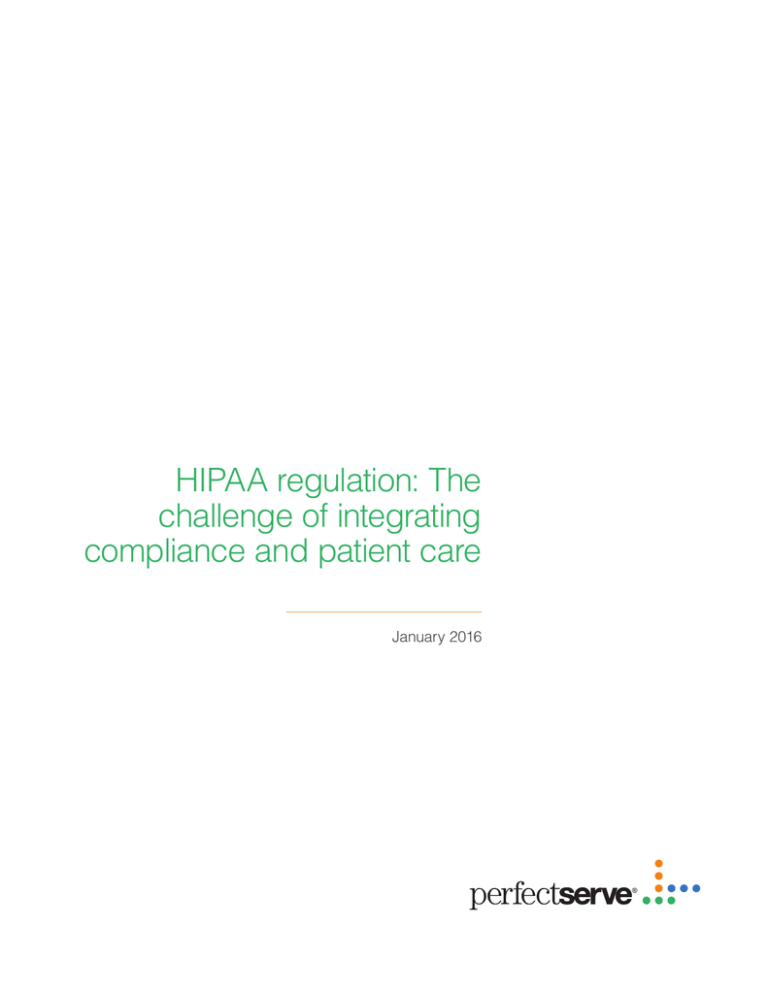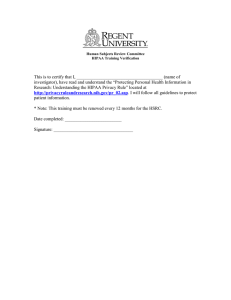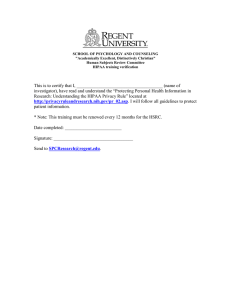
HIPAA regulation: The
challenge of integrating
compliance and patient care
January 2016
Contents
Introduction
3
HIPAA’s “technology neutral” structure
3
Compliance can pave the way for meaningful use
4
Clinician communication varies and is expanding into new modes
6
Current strategies leave room for improvement
8
creates opportunity and challenge
Unified care team collaboration platforms are underutilized 10
Sources 11
perfectserve.com | 866.844.5484 | @PerfectServe
Published as a source of information only. The material contained
herein is not to be construed as legal advice or opinion.
©2016 PerfectServe, Inc. All rights reserved. PerfectServe® is a registered trademark and
PerfectServe Synchrony™ and Problem Solved™ are trademarks of PerfectServe, Inc.
2
Introduction
The expansion of communication technology within healthcare
organizations involves great promise and great risk.
Keeping information flowing and the right people connected at the right
time creates potential for more effective patient care and population health
management.
But a greater number of moving parts also means greater risk. With
personal health data moving at greater frequency through an increasing
variety of digital channels, the complexity of communicating in a secure
manner as mandated by HIPAA regulations is on the rise, as is the risk to
the confidentiality and integrity of patient data.
While the complexities of compliance—and the penalties for breaches—
are daunting, the true challenge of HIPAA regulations for healthcare
organizations is to integrate security compliance into their overall goals
of providing high-quality individual patient care and improving population
health management. Secure communication is mandatory and vital for
patient confidentiality, but it is not intended to be a barrier to high-quality,
efficient care.
In fact, HIPAA regulations are intended to mesh with and provide a
foundation for the kind of proper, efficient exchange of information
that grounds new models of collaborative care. HIPAA’s core mandate
is threefold: confidentiality, integrity and availability. Getting HIPAA
compliance right means greater communication and, ultimately, a positive
impact on patient care. To make this happen, healthcare organizations
need to assess how their members communicate, building compliance
into the model in ways that enhance workflow. Finding secure ways to
encourage and streamline the flow of information can align the need for
HIPAA compliance with the trend toward greater collaboration and the
goal of better patient care.
HIPAA’s “technology
neutral” structure
creates opportunity
and challenge
HIPAA Security Rule regulations require all covered entities to subject
their policies, procedures and technical infrastructure to ongoing
risk analysis and to implement a comprehensive strategy to ensure
confidentiality, integrity and availability of electronic personal health
information (ePHI), however and whenever it is stored or communicated.
3
Any method of communicating ePHI must, under the Security Rule, meet
technical standards for Access Controls, Audit Controls, Integrity, Person
or Entity Authentication and Transmission Security.
However, the law does not regulate or provide guidance on the specific
technologies health organizations may use to store and communicate
ePHI. The law is intentionally technology neutral; it does not prescribe or
restrict storage or communication methods—it only mandates that they
meet security standards in these areas.
For healthcare organizations, this is good news. The law does not restrict
methods of communication or specify use of technologies that are
continually becoming outdated. This encourages flexibility and innovation,
as new ways of communicating can fuel new ways of coordinating care.
The law permits individual organizations to assess and adopt the
technologies they feel will best serve their overall goals and structure.
However, this flexibility also comes at a price. The burden falls on
healthcare organizations to structure their communication strategies,
proactively vetting and choosing technologies that fit in with overall
healthcare goals. They also must ensure that every aspect of the way they
handle sensitive personal health information is secure—every method of
communication, every device, every software platform, every network.
As methods of communication change and proliferate, the task becomes
larger and more complex, requiring greater strategic planning and more
organizational resources.
Compliance can
pave the way for
meaningful use
Facing this challenge, organizations may simply focus on or
feel overwhelmed by the technical complexity of bringing their
communications into compliance—losing sight of a larger potential.
The flexibility within the Security Rule is essential to achieving its third
core tenet: availability of information. The ability to store and transmit
data securely means that it can be shared among all those on the care
team—keeping the right people informed in a timely manner. According
to the Department of Health and Human Services, “permitting the
appropriate access and use of that information, ultimately promotes the
use of electronic health information in the industry—an important goal
4
of HIPAA.”1 Security compliance actually encourages the exchange of
information that can bring about greater efficiencies and better outcomes
in our healthcare model.
The intent to dovetail compliance with coordination improvements is
exemplified in the push to encourage “meaningful use” of electronic health
records (EHRs). Starting in 2011, the Centers for Medicare & Medicaid
Services (CMS) began administering an incentive program to promote the
transition to electronic health record systems. The goals of this program
are not only to solidify patient data security but also to enhance the
ability of healthcare organizations to use that data in meaningful ways.
Securing data in compliance with HIPAA regulation through an EHR can
not only “maintain privacy and security of patient health information,” but
also enable healthcare organizations to “improve quality, safety, [and]
efficiency, and reduce health disparities; engage patients and family; [and]
improve care coordination, and population and public health.”2
While related to a single aspect (EHRs) of the data storage and
communication technologies covered by the Security Rule, the meaningful
use program crystalizes the potential that secure communication systems
hold. The ability to store and communicate data securely means the
ability to use that data responsibly and creatively to improve delivery of
quality healthcare for individual patients and system-wide. The stages
of a meaningful use EHR program defined by CMS [Table 1] show
how such technical advances could have far-reaching effects on many
aspects of our healthcare system, from public health initiatives to greater
engagement of patients and families in their own care.
Ultimately, it is hoped that meaningful use of HIPAA-compliant
technologies will result in:
• Better clinical outcomes
• Improved population health outcomes
• Increased transparency and efficiency
• Empowered individuals
• More robust research data on health systems3
This vision depends, however, on systems that can meet the technical
5
security standards required by HIPAA, and streamline workflow and
improve clinician communication.
Table 1
Source: www.healthit.gov/providersprofessionals/how-attain-meaningful-use
Stage 1:
Meaningful use
criteria focus on:
Stage 2:
Meaningful use
criteria focus on:
Stage 3: Meaningful
use criteria focus on:
Electronically
capturing health
information in a
standardized format
More rigorous
health information
exchange (HIE)
Improving quality, safety
and efficiency, leading
to improved health
outcomes
Using that
information to
track key clinical
conditions
Increased
requirements for
e-prescribing and
incorporating lab
results
Decision support for
national high-priority
conditions
Communicating
that information for
care coordination
processes
Electronic
transmission
of patient care
summaries across
multiple settings
Patient access to
self-management tools
More patientcontrolled data
Access to
comprehensive patient
data through patientcentered HIE
Initiating the
reporting of clinical
quality measures
and public health
information
Using information
to engage patients
and their families in
their care
Clinician communication
varies and is expanding
into new modes
Improving population
health
The challenge of finding the best HIPAA-compliant communication
strategies is particularly pressing as, in the search to improve patient care
through clinician coordination and patient communication, healthcare
organizations are increasingly relying on a complex, often ad hoc, array
of technologies and communication platforms. The current workflow and
communication model is high-volume and intricate.
Clinicians coordinate care within networks and with external
partners using a host of devices and applications, generating a high
6
volume of contacts. In an analysis of PerfectServe data from three
hospitals, representing an aggregate of 774 beds and 54,000 annual
admissions, clinicians initiated more than 680,000 calls and messages
to approximately 900 physicians annually. In a recent online study
conducted by Harris Poll on behalf of PerfectServe among various
healthcare professionals, data further reveals the intricacy of the system.
Phone calls, text messages, email, EHRs, locating an individual for a
face-to-face conversation—all are used with varying frequency according
to the preferences of the individual clinician, the type and complexity of
information sought, and whether the recipient of the message is within
the clinician’s organization or is an outside partner.4 Recent data also
indicates that multiple platforms rather than a unified system is the norm:
in a study of nearly one thousand healthcare professionals, 69% indicate
their organization uses multiple applications and technologies for secure
communication.5 An organization must account for all of these methods in
assessing risk to patient data and must ensure that all methods meet the
security standards set by HIPAA.
Additionally, health organizations are using an ever broader and more
technically complex system of communications to optimize population
health management [Table 2]. These methods serve to improve quality
and availability of care, but also rely on the transmission of patient data.
More contacts and more methods of communication between clinicians
and their patients mean more points at which that health data could be
vulnerable and more systems to bring into compliance.
7
Follow-up patient phone calls
83%
Online patient portals
10%
74%
Unified secure communication platform
16%
46%
Patient text reminders/updates
41%
Telemedicine
39%
Remote coordinations
25%
26%
22%
36%
24%
Remote monitoring
32%
25%
Mobile care team communications
32%
24%
Video conferencing
36%
Remote consults
31%
0%
Currently use
20%
19%
23%
40%
60%
80%
100%
Plan to use within the next 12 months
Table 2
Source: Harris Poll, April 2015
Q920: Which of the following technologies
does your organization currently use or
plan to use within the next 12 months to
optimize population health management?
Thus, the reality of how clinicians communicate creates a maze of
communication technologies for healthcare organizations to submit to risk
analysis and bring up to security standards. As healthcare organizations
continue to embrace collaboration and the breadth of communication
technologies that make it possible, HIPAA compliance will only become
more complex.
Base: All Qualified Respondents (n=955)
Current strategies leave
room for improvement
How successful are health organizations in meeting this challenge?
Studies show that while most healthcare organizations are prioritizing
data security, current strategies leave significant frustration and room
for improvement both in compliance strategies themselves and in the
integration of compliance with improved workflow.
Organizations have HIPAA-compliance risk mitigation strategies in
place and many are working to improve them in the wake of recent data
breaches. A recent survey shows the vast majority work in a group that
8
84%
Indicate their health
organization has a risk
has an official risk mitigation strategy, and 4 out of 5 (83%) believe that
secure communication is a top priority for their organization; nearly half
indicate their group has made changes to that plan in light of recent
prominent data breaches.6
mitigation plan for HIPAA
But the solutions most rely on are not ideal. Despite the overall emphasis
46%
dissatisfaction exist with methods of secure communication, patient data
Say their health
organization has instituted
security measures in
response to news of 2014
healthcare data breaches
61%
Agree that HIPAA
regulations pose an
on security and level of organizational commitment, frustration and
is still being transmitted in unsecure ways, and barriers to communication
are impacting patient care. The recent survey indicates that:
• For most, the strategies necessary for compliance have not been
neatly integrated into their workflow: 61% feel that HIPAA regulations
pose an obstacle to efficient communications and collaboration within
their care team.
• Compliance is a priority, but the tools available are not always up
to the task: nearly 3 in 10 (29%) are dissatisfied with the secure
communication technology in their organization’s current strategy.
obstacle to efficient
• Despite efforts, the failure of healthcare organizations to create
collaboration within
the most commonly cited reasons for dissatisfaction are
communication and
the care team
a unified, complete system is the primary source of frustration:
the variance in communication technologies used by different
members of the organization (68%) and the failure to have secure
communication accessible to all members of the organization (55%).
Lack of uniformity in the system and universal access to all
team members are much stronger factors in dissatisfaction even
than technical deficiencies such as outdated, unreliable software or
programs that are complicated to use.
• When a web of disparate technologies is in place and not everyone
is included in the same system of communication, collaboration and
efficient patient care face a hurdle: 7 in 10 clinicians (69%) indicate
that patient care is often delayed while they wait for information
about a patient.7
The gaps in an organization’s strategy can also lead to failures in
compliance, leaving patient health information vulnerable to exposure
or corruption. Despite the emphasis on communication security and
9
the strategies in place, 13% of healthcare professionals admit that, in
order to facilitate patient care, they have sent patient health information
through unsecure text or voice messages with their personal smart
phone in the past year, and 21% acknowledge having received unsecure
communications from colleagues via the same manner for this purpose.8
While breaches occur for many reasons, the majority can be traced
to inadequately planned processes and tools organizations develop
internally to manage this complicated landscape. A 2015 Ponemon
Institute study of ePHI security breaches indicates that the underlying
causes of these breakdowns are most often an ad hoc process (34%)
or a manual process or tool developed by the organization itself (27%).
Incidents traced to an automated process or third-party software occur at
a much lower rate (13%).9
Unified care team
collaboration platforms
are underutilized
For healthcare organizations that are increasingly embracing more
collaborative care models and the technologies that make care more
accessible and efficient, the answer to HIPAA compliance must focus
simultaneously on data security and availability. In a world of rapidly
expanding communication methods and applications, points at which the
communication model can be streamlined as well as secured can reduce
the burden of ongoing risk management on organizations.
A unified care team collaboration platform can help organizations simplify
their risk management strategy, relying on a single integrated system
rather than tracking and juggling multiple systems. It can also ameliorate
the two main causes of dissatisfaction with secure communication within
healthcare organizations: not all members using the same technologies
and not all members having access to secure communication technology.
However, this strategy is not being as widely implemented as it could
be, with nearly 7 in 10 (69%) healthcare professionals reporting that
their organization deals with multiple technologies rather than one
unified platform.
As organizations review and work to improve their risk management
strategies, a unified communications platform can be an important piece
of the move toward integrating HIPAA compliance with the best patient
care and population health management possible.
10
Sources
1. “Security 101 for Covered Entities.” HIPAA Security Series: Volume 2,
Paper 1. Department of Health and Human Services. 2007. Available
at http://www.hhs.gov/ocr/privacy/hipaa/administrative/securityrule/
securityruleguidance.html.
2. https://www.healthit.gov/providers-professionals/meaningful-usedefinition-objectives. Accessed December 7, 2015.
3. https://www.healthit.gov/providers-professionals/meaningful-usedefinition-objectives. Accessed December 7, 2015.
4. PerfectServe Survey Results, April 2015. Harris Poll.
The PerfectServe survey was conducted online by Harris Poll on
behalf of PerfectServe between February 12 and March 6, 2015. The
research was conducted among 955 medical professionals in the
following occupations: hospitalist (n=150), primary care physician in
an office (n=150), specialist physician in a hospital (n=102), specialist
physician in an office (n=101), hospital administrator (n=170), office
manager/practice administrator* (n=81), nurse in a hospital (n=101)
and case manager (n=100). Office-based respondents work in an
office with 25 or more physicians. Hospital-based respondents work
in a hospital with 200 or more beds. Physician respondents are duly
licensed in the state where they practice. Data were not weighted and
are only representative of those who completed the survey.
*Nine office managers/practice administrators work in an office with
fewer than 25 physicians.
When referring to this study, “clinicians” indicates a subset of
respondents excluding administrators. The subset includes hospitalist
(n=150); PCP office (n=150); specialty physician, hospital (n=102);
specialty physician, office (n=101); nurse, hospital (n=101); and case
manager (n=100), for a total base of n=704.
5. PerfectServe Survey Results, April 2015. Harris Poll.
6. PerfectServe Survey Results, April 2015. Harris Poll.
7. PerfectServe Survey Results, April 2015. Harris Poll.
11
8. PerfectServe Survey Results, April 2015. Harris Poll.
9. Ponemon Institute, Fifth Annual Benchmark Study on Privacy &
Security of Healthcare Data, May 2015. Available at
http://www.ponemon.org/library/fifth-annual-benchmark-study-onprivacy-security-of-healthcare-data.
12


